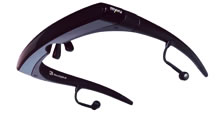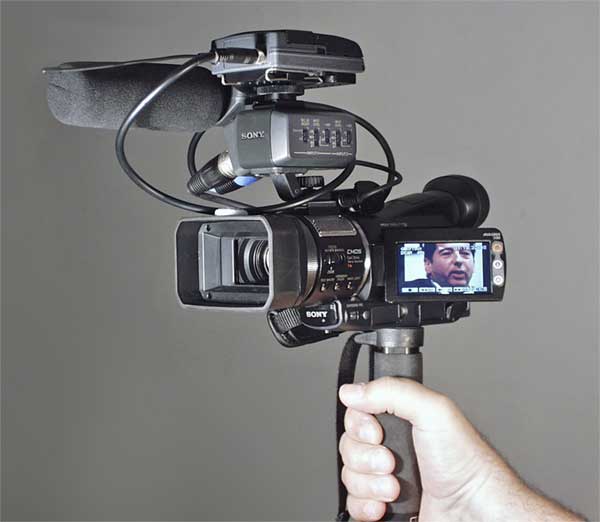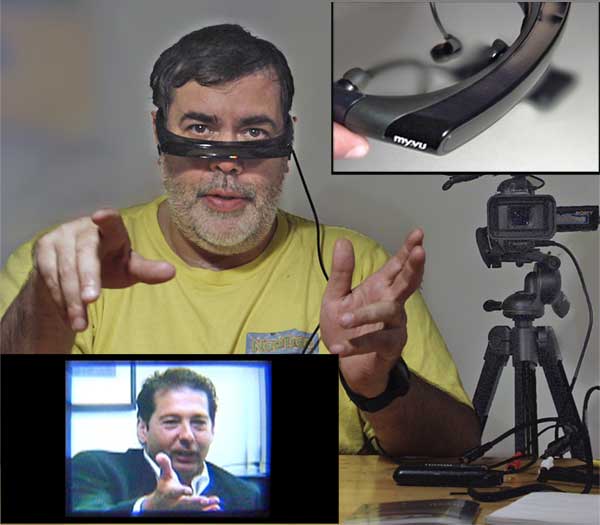September 10, 2006

MyVu Personal Media Viewer
MSRP 269.00
www.microoptical.net
I once said you won't catch me dead watching
a Hollywood movie on a video iPod.
I'm a trade show junkie. Recently I did a SIGGRAPH Boston shoot as a one-man band, for Creative Planet's Digital Production Buzz, which now offers video content for podcast. I used my new Sony HVR-A1U, rented a Lectrosonics wireless mic to take advantage of the camera's pro balanced XLR inputs, and bought a Manfrotto monopod (because SIGGRAPH like a lot of trade shows these days doesn't allow tripods in the aisles). I added a feather-light Sima LED in case I needed it.

Shooting went well, considering I was getting bumped by floor traffic, working in wildly varied lighting conditions, and every afternoon about 3:00 PM began to introduce what I call my Three O'clock Weave, a new camera style resulting from low blood sugar and SHO-Show Hall Overload.
It feels a bit schizoid interviewing while filming from a camera you're holding a yard away on a monopod, but this way you get the proper interview look, with the subject oriented to interviewer just off-camera, as if you the viewer is observing a conversation as a third party, which of course, you are. I kept this orientation consistent throughout the shoot, always on the camera's left, because the LCD screen folds out only on that side. I had no other way to quickly check composition and focus without moving to the viewfinder. I discovered checking fine focus while rolling would be impossible-the camera's "expanded focus" function is disabled while recording. And under certain conditions, the camera likes auto-focusing on the background rather than the subject!
The camera's single CMOS chip holds up impressively for this kind of ENG shoot, and the LED lamp boosted very dimly-lit subjects only when I needed it. As the shoot went on, I gradually unlocked more and more auto settings for more manual control. But riding focus was the most critical problem I needed to address as I unlocked autofocus.
To engage a subject in an interview while
operating the camera was a handful. I was wearing headphones
for audio but I kept breaking eye contact to look at the LCD.
And of course then so did the subject, which sometimes makes
them look distracted or nervous!
This is why the concept of "crew" became popular. Most
times, it should remain so. But in the fast and frantic world
of run and gun news and event production, a crew of only two
, and often only one, covers the venue.
To refine my work, I needed some kind of remote eyeballs for the next gig. What to do??
Hello, Google.
Most of the listed headwear available is just that, HMD-Head-Mounted Displays, for game players and VR technofreaks. I just needed my camera view and an image I could reference for fine focus. And I didn't want to wear a helmet to do that. A monocular of some kind, or glasses!
I came up with two likely companies, iCuiti, out of Rochester, NY, and MicroOptical out of Boston. Boston would be less gas, and from the website the product looked lighter and less conspicuous, too.
"It is lighter, and less conspicuous," said Bruce Lampert, VP, Sales and Business Development of MicroOptical Corp, as we sat down to conduct a test video interview. Customer Service rep Roxanne Brengle presented a crisp new MyVu set for me to open. I plugged them into the Sony through Sony's supplied analog-out adapter cable fitted with gender-changing RCA plugs, which fit into MyVu's supplied composite video/ stereo audio cable.
I fired them up from the permanently attached MyVu power pack, which draws from three AA batteries. It properly sensed the NTSC signal, I donned them, and in seconds we conducted an interview which included remote-control zoom and fine manual focus as needed, while I kept my gaze on my subject without once turning to the LCD.
The glasses are so slim you can easily see the world around you, over the top and even through the glasses-- transparent tinted viewspace on either side of the screen. This design offers what MicroOptical's founder Mark Spitzer calls "situational awareness." It's among the many features originally developed for tank drivers, digital MP's, and also civilian applications such as surgery and high-end video production. The company started in 1995 to develop for these markets. MyVu is their first consumer venture, and MicroOptical premiered the product as an iPod accessory at MacWorld 2006.

"We brought 200 units to the show. We sold out in the first day," recalls Bruce. "We had to stretch our remaining 50 units over the rest of the show. We really didn't expect the response." Which was so good, the company will make a return to MacWorld San Francisco in January 2007.
Inside the lightweight glasses, MyVu's optical engineering delivers a 27"consumer TV screen (auto-sensing NTSC or PAL), which hangs in space seemingly about six feet away. The video frame size is actually 320 X 240, optically optimized with one screen for each eye, blended as a single screen. What's the frame like? It's a standard definition 4:3 color TV, with a slight glow around the edges of the binocular image. There are no adjustments. It just works. The glasses, like iCuiti's, feature built-in earbuds for stereo sound. Replacement bud tips are also supplied. But if you look closely at iCuiti's model you'll see it's a thicker, heavier design (and pricier, too). MicroOptical's patented image pump is installed along the edge of the glasses, not in the middle, allowing a thinner bridge.
A lot of design thought and focus group testing went into product development, even including custom snap-in nose bridges. Yes: nose bridges. Select the one which grips your nose thickness comfortably and you can ride the glasses low on your nose to glance up and see the world around you-- but please, you'll be arrested if you try driving with these, don't even think about it. These are ideal for waiting in line in supermarkets, in airports, on the plane or train, with MyVu attached to a DVD player, or a video iPod.
However, I had a friend who wears eyeglasses try them on. That didn't go so well, because there's no optical adjustability. But if you read the booklet you'll see that problem will shortly be addressed with a selection of clip-on lenses which allow you to remove your glasses to watch TV, echoing their snap-in nose bridge strategy.
Naturally, I had a wishlist for "MyVu Pro." My dream combination of features includes 640 X 480, switchable 4:3- 16:9, plus anamorphic aspect ratio unsqueeze -- folks using widescreen lenses while shooting with SD cameras will need this. I also dreamed for chroma, luma and audio adjustment thumbwheel controls. And finally, wireless, from a camera transmitter to battery pack/receiver to glasses. You bet it'll cost more!
It turns out most all these features are deployed in some of MicroOptical's higher-end models. They make a monocular device advertised on their website just for video applications, which is 640 X 480, but not wireless. They make a Bluetooth product for surgeons which delivers bitmap data (think Apple II ASCII characters), so a patient's vital sign info can be transmitted instantly to the doctor's monocular eyepiece-but not full motion video.
"15 or 30-frame motion video demands a lot more bandwidth," comments Bruce. "We are definitely investigating smooth wireless video internally and with strategic partners. It's not easy. It's a moving target." But for now, wearable TV is here. Watch this space.
See the SIGGRAPH clips --which weren't shot with MyVu-- at www.digitalproductionbuzz.com. The video podcast clips are available for download to iTunes or other favorite video player, and the Buzz crew compressed them beautifully in the H264 codec. I have viewed these clips on a 30"Apple Cinema Display watching from 6 feet and they hold up amazingly well. Internet TV is here.
Then watch the MyVu/MicroOptical clip when that's available, late September, to see how valuable it can be, and how it can free you from single-side shooting as well as focus issues.
I thought MyVu was way cool. Which is why I shelled out for a pair. Recall that I once said you won't catch me dead watching a Hollywood movie on a video iPod. Well, I may have died and gone to video heaven.
 When
he isn't watching Conan or an interview subject on his MyVu,
Loren S. Miller edits, writes, and shoots. Reach him anytime
at lormiller@mindspring.com.
Visit the LAFCPUG
store for discounts on his KeyGuides, or visit www.neotrondesign.com
for the full range of professional placemats.
When
he isn't watching Conan or an interview subject on his MyVu,
Loren S. Miller edits, writes, and shoots. Reach him anytime
at lormiller@mindspring.com.
Visit the LAFCPUG
store for discounts on his KeyGuides, or visit www.neotrondesign.com
for the full range of professional placemats.